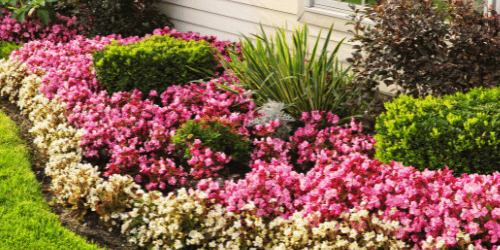Pollinators play a crucial role in maintaining healthy ecosystems and ensuring the reproduction of flowering plants. By creating a pollinator-friendly garden, you not only enhance the beauty of your outdoor space but also contribute to the well-being of local wildlife. In this blog post, we’ll explore effective strategies for attracting pollinators to your seasonal flower garden in McKinney, TX.
To attract pollinators, focus on providing a diverse range of nectar-rich flowers, suitable nesting sites, and pesticide-free environments.
Choosing the Right Flowers
Native Plants
Native plants are well-suited to the local climate and soil conditions, making them perfect for attracting native pollinators. Researching native wildflowers and perennials that thrive in McKinney’s specific ecosystem can help create a vibrant and sustainable garden. Examples of such plants include the Texas bluebonnet (Lupinus texensis), black-eyed Susan (Rudbeckia hirta), and purple coneflower (Echinacea purpurea). These plants not only enhance the beauty of your garden but also support local wildlife, ensuring a healthy and balanced environment. By choosing native plants, you contribute to the conservation of local species and promote ecological stability.
Blooming Seasons
Planning your garden to have flowers blooming throughout the growing season ensures continuous beauty and supports pollinators. For early spring, consider planting crocuses, daffodils, and wild violets. These early bloomers add vibrant colors after winter. In the summer, bee balm, salvia, and zinnias are excellent choices, providing a variety of hues and attracting bees and butterflies. As fall approaches, asters, goldenrod, and sedum can take over, offering rich colors and nectar for late-season pollinators.
Color Palette
Opting for a variety of flower colors in your garden attracts different pollinator species. Bees are drawn to blue, purple, and yellow flowers, making plants like lavender, coneflowers, and sunflowers ideal choices. Hummingbirds, on the other hand, prefer red and orange blooms, so consider adding plants like trumpet vine, red salvia, and hibiscus. By incorporating a diverse color palette, you can create a vibrant and inviting garden that supports a wide range of pollinators, enhancing both the beauty and ecological value of your outdoor space.
Creating Pollinator-Friendly Habitats
Shelter and Nesting Sites
Installing bee houses, butterfly boxes, and nesting blocks can create a welcoming environment for various pollinators. Leaving dead wood or hollow stems provides essential nesting sites for solitary bees. Additionally, offering sheltered areas for butterflies helps them find refuge during windy or rainy weather. These steps not only support the health of pollinator populations but also enhance the biodiversity and beauty of your garden.
Water Sources
Placing shallow dishes with water in your garden provides a vital resource for pollinators. Adding pebbles or rocks allows bees and butterflies to perch safely while drinking. This simple addition helps keep pollinators hydrated and supports their well-being, contributing to a healthy and thriving garden ecosystem. By ensuring pollinators have access to water, you create a more inviting and supportive environment for them.
Avoid Pesticides
Pesticides can harm pollinators, so it’s important to use natural pest control methods. Encouraging beneficial insects like ladybugs and lacewings can help manage pest populations without chemicals. These insects prey on common garden pests, providing a natural and effective way to protect your plants. By avoiding pesticides and fostering beneficial insects, you create a safer environment for pollinators and support a healthier garden ecosystem.
Planting Techniques
Grouping Flowers
Planting clusters of the same flower species in your garden can effectively attract pollinators. Pollinators are more likely to visit and stay in a concentrated area of similar blooms, making it easier for them to gather nectar and pollen. This strategy not only enhances the visual appeal of your garden but also supports the needs of bees, butterflies, and other pollinating insects, promoting a more vibrant and active pollinator presence.
Companion Planting
Pairing compatible plants can enhance pollination in your garden. For example, marigolds deter pests while attracting bees, making them a great companion for vegetables and other flowering plants. By strategically planting marigolds alongside your crops, you can create a healthier garden environment that supports pollinators and keeps pests at bay. This approach not only improves plant health but also boosts pollination efficiency, leading to better yields and a more thriving garden.
Container Gardens
Even small spaces can support pollinator-friendly plants, making container gardening a great option. Choose containers with drainage holes and fill them with suitable flowers such as lavender, salvia, or bee balm. These compact gardens provide valuable resources for pollinators while adding beauty to balconies, patios, or windowsills. With careful selection and placement of containers, even the tiniest outdoor area can become a haven for bees, butterflies, and other beneficial insects.
Enhancing Pollinator Habitats
Providing Shelter and Nesting Sites
To support pollinators like bees and butterflies, consider implementing various habitat features in your garden Install bee houses or insect hotels to attract solitary bees. These structures provide nesting sites for various bee species. Set up butterfly boxes in sunny spots. These vertical wooden structures offer shelter during windy or rainy weather. Leave some hollow stems or dead wood in your garden. Solitary bees use these natural cavities for nesting.
Water Sources for Pollinators
In your garden, provide shallow dishes filled with water. These serve as essential water sources for bees, butterflies, and other pollinators. Additionally, add pebbles or flat stones to the water dishes. Pollinators can perch on them while drinking, making it easier and safer for them to access the water. By incorporating these simple features into your garden, you can help ensure that pollinators have access to water, contributing to their health and well-being.
Avoiding Harmful Chemicals
Refrain from using chemical pesticides. These can harm pollinators and disrupt the delicate balance of your garden ecosystem. Encourage beneficial insects like ladybugs and lacewings. They help control pests naturally, reducing the need for chemical pesticides while promoting a healthy environment for pollinators. By adopting pesticide-free practices and fostering beneficial insects, you can create a safer and more sustainable garden for pollinators to thrive.
Answering Common Questions
Q1 What about hummingbirds?
A1 Hang hummingbird feeders filled with a sugar-water solution. Plant tubular flowers like salvia and cardinal flower.
Q1 Are there any specific plants for bees?
A2 Yes! Bee balm, lavender, and sunflowers are excellent choices.
The Impact of Local Climate on Pollinators
McKinney’s warm climate allows for extended flowering seasons, benefiting both pollinators and gardeners. However, extreme heat can stress pollinators, so provide shaded areas and water sources.
Climate and Flowering Synchronization
Understanding local climate patterns helps you select flowers that bloom when pollinators are most active. For example, early spring blooms coincide with emerging bees and butterflies.
Seeking Expert Advice
For personalized guidance, consult local gardening experts or visit McKinney’s gardens. They can recommend specific plants and practices tailored to your garden.
Remember, creating a pollinator-friendly garden is not only rewarding but also contributes to the overall health of our environment.
Conclusion Cultivating a Vibrant Pollinator Paradise
Creating a pollinator-friendly garden is more than just a hobby; it’s an act of environmental stewardship. By following the strategies outlined in this blog post, you can transform your McKinney, TX garden into a haven for bees, butterflies, and hummingbirds.
Choose a variety of native flowers that bloom throughout the seasons. From early spring crocuses to fall asters, provide a continuous buffet of nectar-rich blooms. Set up bee houses, butterfly boxes, and water dishes. Leave some dead wood and hollow stems for solitary bees. Avoid pesticides to create a safe environment. Bees love blue, purple, and yellow flowers, while hummingbirds are drawn to red and orange blooms. Mix and match colors to attract a diverse range of pollinators. McKinney’s warm climate allows for extended flowering seasons. However, provide shaded areas and water sources during scorching summer days. Consult local gardening experts and visit botanical gardens. They can offer personalized recommendations based on your garden’s unique conditions.
Visit Us At Tailor Made
For more information and personalized guidance, visit us at Tailor Made Contracting is here to provide you with exceptional landscape design services that transform your outdoor space into a work of art. Whether you’re dreaming of a lush garden, a tranquil patio, or a vibrant play area, we’ll bring your vision to life. Contact us today and let’s create something extraordinary together!







